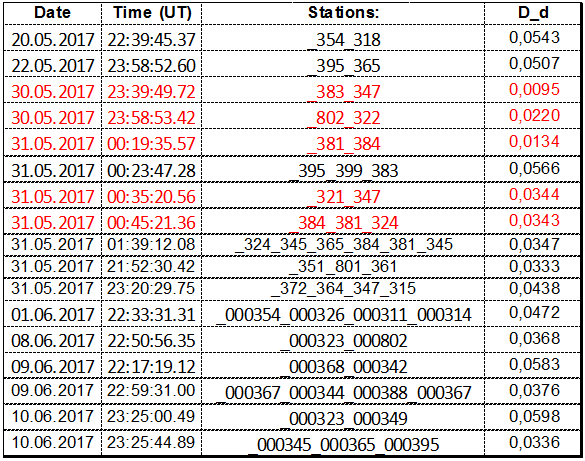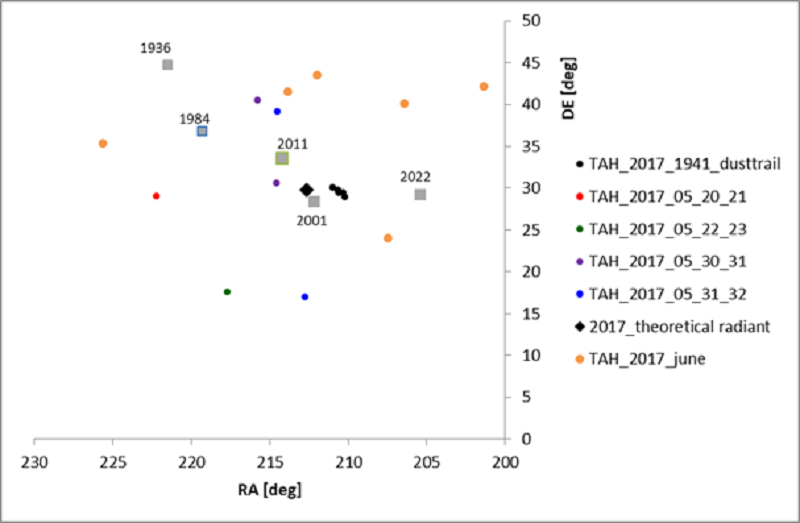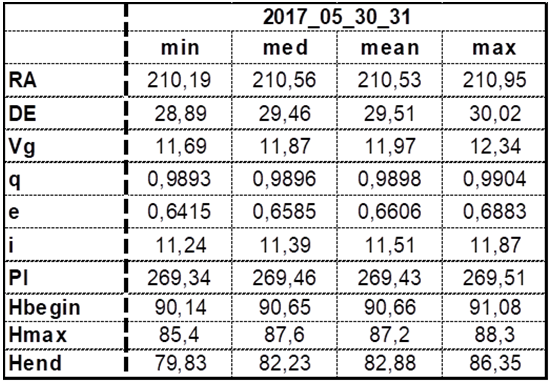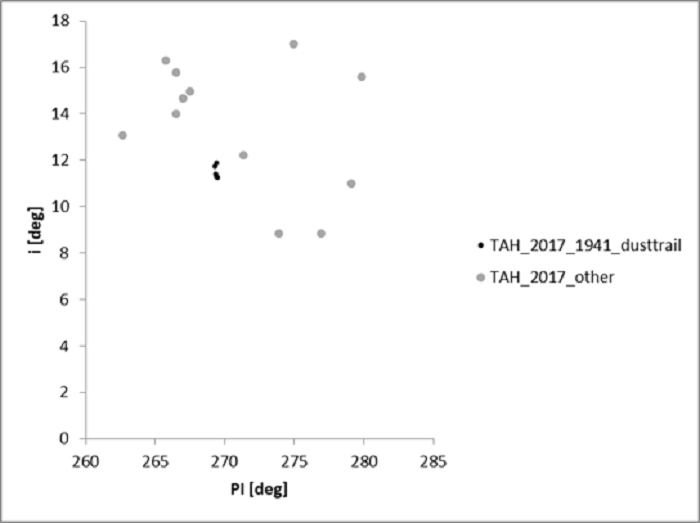Tau Herculids activity in 2017 recorded by CAMS
By Carl Johannink, Jaap van ’t Leven, Koen Miskotte
Abstract
During routine CAMS observations in the night of May 30/31 CAMS BeNeLux collected five meteors in just over an hour, which are associated with comet 73P/Schwassmann-Wachmann. These five meteors appeared from a very narrow radiant, near RA=210 degrees and DE=29 degrees, geocentric velocity (Vg) ~12 km/s, with very similar orbits.
Further searches on the nights around this peak showed another twelve candidates.
The first five meteors very likely belong to the 1941-dusttrail of this comet, that was predicted to produce meteors with a geocentric velocity of 12.4 km/s, radiating from RA=212.6 degrees and DE=29.7 degrees, on May 31,136 this year [1]. A short summary of historical visual observations is also given.
The observations
While processing all the data obtained during this night we immediately noticed five meteors with virtually identical radiantpositions, geocentrical speed and orbital elements. Each single one of these meteors appeared within the space of little over an hour, to be precise between 23:39 UT and 00:45 UT (Table 1). Almost instantly the comet 73P/Schwassmann-Wachmann emerged as being the possible source, according to predictions about the year 2017 possibly showing meteor activity, considering the comet has an orbital period of 5 years. In this case the passage of this comet in 1941 could be considered to be the source of the meteors observed. [1]
What was striking was that the radiantposition of aforementioned meteors originating from the passage of this comet perfectly coincide with the predicted radiantposition on RA=212.6 degrees and DE=29.7 degrees, as shown in Figure 1.
The question arose if, around this date, more orbits could be linked to this comet. Hence the decision to look for a possible match between the orbit of the comet 73P/Schwassmann-Wachmann, and the 1627 orbits that we could record with CAMS in the month of May 2017, as well as the 380 orbits recorded up to and including June 10 2017. For the comparison of all the orbits recorded with respect to similarities with the comet’s orbit, the Drummond criterium was implemented [2]. In 2017 the orbital elements of 73P/Schwassmann-Wachmann are as follows: [3]
Orbital elements valid for 2017-03-28,0 TT = JDT 2457840,5 (based on 1040 observations between 28 November 2010 and 2 June 2017):
| perihelion date | 2017-03-16,84173TT |
| argument of perihelion ω (°) | 199,38777 |
| ascending node Ω (°) | 69,66219 |
| inclination i (°) | 11,23692 |
| eccentricity e | 0,6855140 |
| perihelion distance q (AU) | 0,9721785 |
After that meteors observed in the period of 20 May up to and including 10 June were selected, answering to the Drummond criterium of Dd < = 0.06.
Table 1 shows these meteors with corresponding points of time and the stations that recorded them. The numbers in red concern the TAHs belonging to the dust from 1941.

Table 1. Overview of the stations having recorded the tau Herculids with corresponding points of time and the D-criterium value (in red the five tau Herculids belonging to the dusttrail of 1941).
Figure 1 shows the radiant of these meteors (shown as dots). Also presented, the predicted radiant positions of years in which TAH activity could be expected, as well as years in which it was recorded according to Lüthen, Arlt and Jäger. [1]

Figure 1. Plot of the radiants of the 5 tau Herculides (TAH) of the 1941 dusttrail, the remaining tau Herculids, and the predicted radiant of the years with significant meteor activity.
The concentration of the five tau Herculids originating from the 1941 dusttrail and their proximity to the theoretical radiant predicted by Lüthen, Arlt, and Jäger [1] is significant. The fact that the comet has had several close passages to Jupiter in the past explains the rather wide spread of radiant positons in the seperate years included in the plot. Besides that, the radiant is situated near the antapex in Hercules, by way of which small changes in the orbit result directly in bigger changes in radiantpositon.
The similarities between the five tau Herculids of the 1941 dusttrail are represented in Table 2, including the minimum, maximum, mean and median value for several orbital elements.

Table 2. Maximum and minimum, mean and median values for radiant, geocentric speed and a number of orbital elements of the five tau Herculids (of the 1941 dusttrail) recorded in the night of May 30/31 2017.
This result is the second successful confirmation of tau Herculids activity by CAMS. In 2011, when CAMS California was being started up, it recorded in total 12 meteors, among which 3 tau Herculids, on 2 June between 4:00 and 12:13 UT. These three meteors had a radiantpositon RA=215.5 +/- 0.4 degrees and DE = 34.0 +/- 0.6 degrees [4].
In that year prediction and observation coincide to a large extent as well: less than 1 degree deviation of the radiant positon in the prediction of possible activity on 2 June at around 5:45 UT (Figure 1) [1]. The same article refers to the year 2022 too. According to, amongst others, Vaubaillon & Brown [5] a sort of ‘diluting’ effect on the denseness of the older dusttrails can be observed, as these will probably be rather extended by then.
With the necessary premises based on the past (among others about the ZHR in 1930) they come to a ZHR score of maximally 10 for the dusttrails of 1892 and 1897. However, according to Lüthen, Arlt & Jäger [1] the rather recent dusttrail of 1995 is the one being closest to Earth. Chances are that this is a dusttrail with a higher dust density as a result of the fragmentation of the comet into at least four pieces in 1995.
Besides that, the calculated distance between the 1995 dusttrail and the Earth is, in that year, a lot smaller than in all the previous cases. In Maslov [6] we see, because of that reason, two peak moments for 2022.
The first peak, with a ZHR of some dozens, on 31 May 2022 at around 3:11 UT, caused by older dusttrails, and a more substantial peak with regard to the 1995 dusttrail at around 5:15 UT with a ZHR score of 600-700, possibly rising into the thousands. To conclude with, Figure 2 shows a plot of the orbital elements PI versus i for the complete set of data of tau Herculids.

Figure 2. Plot of PI versus i for the meteors discussed.
Conclusion
In the last decade of May 2017 and the first decade of June, 17 tau Herculids could be recorded. Of five tau Herculids recorded in the night of 30/31 May, the great coincidence between the radiant positon and the predicted value for activity of the 1941 dusttrail in 2017 is significant [1].
Moreover, the remaining orbital elements and the light curves show a very similar picture. After 2011, 2017 is the second year in which activity of tau Herculids could be recorded, conform the predictions.
The predictions for 2022 currently vary between a ZHR score of ~10 and several thousands, depending on which dusttrail is being considered. Hopefully, over the next few years, the model makers will be able to make a more reliable prediction about the activity in that year, especially for the dusttrail of 1995.
In the period of 2000 up to and including 2014, per year only few tau Herculids were observed visually by dutch observers.
Acknowledgments
A word of thanks to Reinder Bouma for valuable advice and critically reading through this article. And, of course, a word of thanks to all CAMS posts for their full commitment and swift processing of data.
References
[1] H. Lüthen , R. Arlt , M. Jäger , The Disintegrating Comet 73P/Schwassmann-Wachmann 3 and Its Meteors , WGN 29 1/ 2 (2001) , p. 15 – 28
[2] Drummond J. D. (1981). “A test of comet and meteor shower associations”. Icarus 45, p. 545–553
[3] MPEC 2017-L52
[4] CBET 2817
[5] P.A. Wiegert , P.G. Brown , J. Vaubaillon , H. Schijns , The τ Herculid meteor shower and Comet 73P/Schwassmann-Wachmann3 , Mon. Not. R. Astron. Soc 361 , 638 – 644 (2005)
[6] http://feraj.ru/Radiants/Predictions/73p-ids2017eng.html
[7] P. Jenniskens , P.S. Gural, L. Dynneson, B.J. Grigsby, K.E. Newmane, M. Borden, M. Koop, D. Holman, CAMS: Cameras for Allsky Meteor Surveillance to establish minor meteor showers, ICARUS 216 (2011) , p.40 – 61
[8] P. Jenniskens et.al., The established meteor showers as observed by CAMS, ICARUS 266 (2016) 331 – 354






